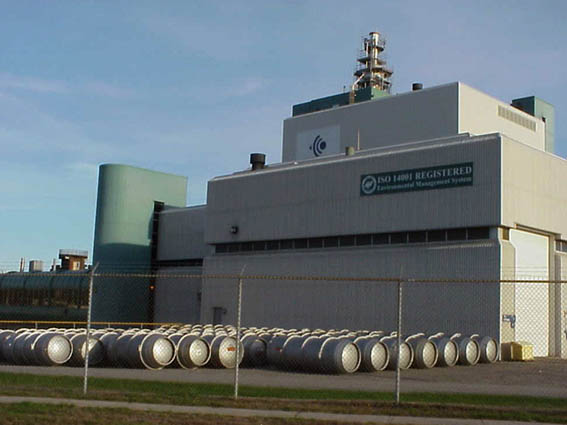Cameco is preparing to resume operations at its uranium hexafluoride (UF6) production plant in Port Hope, Ontario, which has been idle for over a year since it was found that production chemicals had escaped.
 |
| Port Hope (Image: Cameco) |
Cameco voluntarily suspended operations within the UF6 plant following the discovery during construction work in July 2007 that chemicals - including some uranium - had leaked through the floor of the plant into soil and groundwater. It was quickly determined that the chemicals had not travelled beyond the site boundary. Operations at the adjacent UO2 production plant were not affected.
The company told a meeting of the Port Hope municipal council that it has combined extensive ground water control measures with major repairs and improvements to the plant that are intended to prevent uranium and other production-related chemicals from spreading further and to ensure there are no underground leaks in the future.
Andy Oliver, vice president of Cameco's fuel services division, told council members that the Canadian Nuclear Safety Commission (CNSC) had informed the company on 12 September that it had accepted company plans to restart UF6 production. He said that this should happen within the next several days.
Oliver said, "After the CNSC accepted our plan to restart production, we began the final phase of putting the plant back into operation. Since the plant has been shut down for over a year, we have been following a cautious, thorough approach to restart in order to ensure it happens properly and safely." He added, "We have carried out a broad series of corrective actions and other control and preventative measures inside and outside the plant to resolve the issue and to ensure leaks do not occur in the future."
In a statement, Cameco said it expects total remediation costs to be C$50-55 million ($47-52 million). These costs include the investigation of the cause and effects of the leak, rehabilitating the plant and installing a system of wells that collect impacted groundwater around the plant. Improvements to the plant include the replacement of large sections of the ground floor and the application of chemical-resistant coatings to all floors, as well as the removal of some contaminated soil from beneath the building.
Cameco said that it has sufficient hydrofluoric acid (HF) - used in the production of UF6 - to resume operations at a reduced rate that will allow production to continue for about one month. However, its sole supplier of HF has "wrongfully" terminated its long-term supply contract with Cameco, which is now seeking alternative supply sources.
Cleanup plan
Cameco also reported that it is developing a comprehensive program to address other subsurface contamination that is the legacy from some 150 years of various industries operating on its Port Hope site. The company, in consultation with the CNSC and Ontario's Ministry of the Environment, is in the process of completing this program that will provide more details about contamination across the site, most of which pre-dates Cameco's ownership of the property.
The company has received a preliminary report on the investigation which is part of the program that will be used in the development of an environmental management plan for the entire site. An important part of the plan will be Cameco's multi-year site cleanup and modernisation project, known as Vision 2010. The project, which includes removing up to 150,000 cubic metres of contaminated soil, building materials and stored historic waste, is currently undergoing an environmental assessment.





_69614.jpg)

_15447.jpg)




